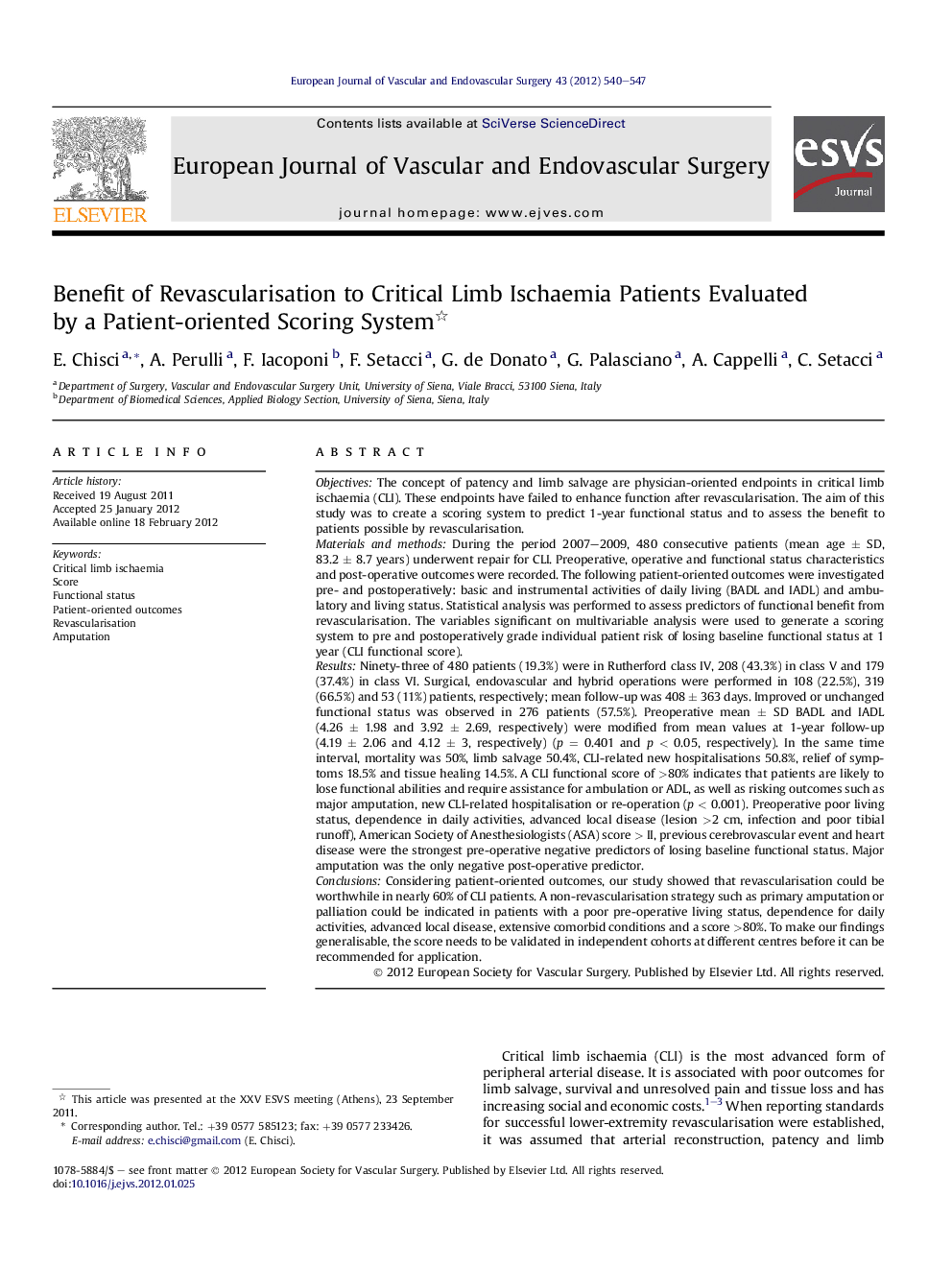| کد مقاله | کد نشریه | سال انتشار | مقاله انگلیسی | نسخه تمام متن |
|---|---|---|---|---|
| 2912965 | 1575478 | 2012 | 8 صفحه PDF | دانلود رایگان |

ObjectivesThe concept of patency and limb salvage are physician-oriented endpoints in critical limb ischaemia (CLI). These endpoints have failed to enhance function after revascularisation. The aim of this study was to create a scoring system to predict 1-year functional status and to assess the benefit to patients possible by revascularisation.Materials and methodsDuring the period 2007–2009, 480 consecutive patients (mean age ± SD, 83.2 ± 8.7 years) underwent repair for CLI. Preoperative, operative and functional status characteristics and post-operative outcomes were recorded. The following patient-oriented outcomes were investigated pre- and postoperatively: basic and instrumental activities of daily living (BADL and IADL) and ambulatory and living status. Statistical analysis was performed to assess predictors of functional benefit from revascularisation. The variables significant on multivariable analysis were used to generate a scoring system to pre and postoperatively grade individual patient risk of losing baseline functional status at 1 year (CLI functional score).ResultsNinety-three of 480 patients (19.3%) were in Rutherford class IV, 208 (43.3%) in class V and 179 (37.4%) in class VI. Surgical, endovascular and hybrid operations were performed in 108 (22.5%), 319 (66.5%) and 53 (11%) patients, respectively; mean follow-up was 408 ± 363 days. Improved or unchanged functional status was observed in 276 patients (57.5%). Preoperative mean ± SD BADL and IADL (4.26 ± 1.98 and 3.92 ± 2.69, respectively) were modified from mean values at 1-year follow-up (4.19 ± 2.06 and 4.12 ± 3, respectively) (p = 0.401 and p < 0.05, respectively). In the same time interval, mortality was 50%, limb salvage 50.4%, CLI-related new hospitalisations 50.8%, relief of symptoms 18.5% and tissue healing 14.5%. A CLI functional score of >80% indicates that patients are likely to lose functional abilities and require assistance for ambulation or ADL, as well as risking outcomes such as major amputation, new CLI-related hospitalisation or re-operation (p < 0.001). Preoperative poor living status, dependence in daily activities, advanced local disease (lesion >2 cm, infection and poor tibial runoff), American Society of Anesthesiologists (ASA) score > II, previous cerebrovascular event and heart disease were the strongest pre-operative negative predictors of losing baseline functional status. Major amputation was the only negative post-operative predictor.ConclusionsConsidering patient-oriented outcomes, our study showed that revascularisation could be worthwhile in nearly 60% of CLI patients. A non-revascularisation strategy such as primary amputation or palliation could be indicated in patients with a poor pre-operative living status, dependence for daily activities, advanced local disease, extensive comorbid conditions and a score >80%. To make our findings generalisable, the score needs to be validated in independent cohorts at different centres before it can be recommended for application.
Journal: European Journal of Vascular and Endovascular Surgery - Volume 43, Issue 5, May 2012, Pages 540–547